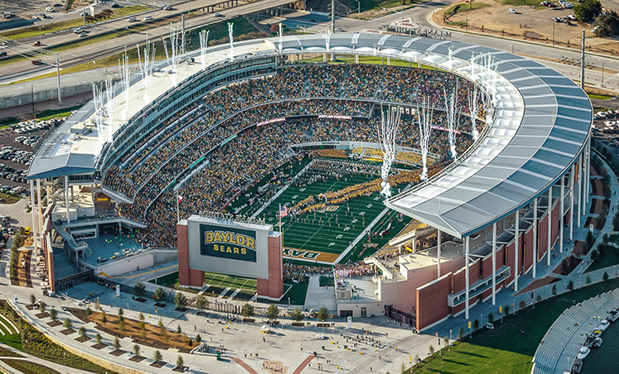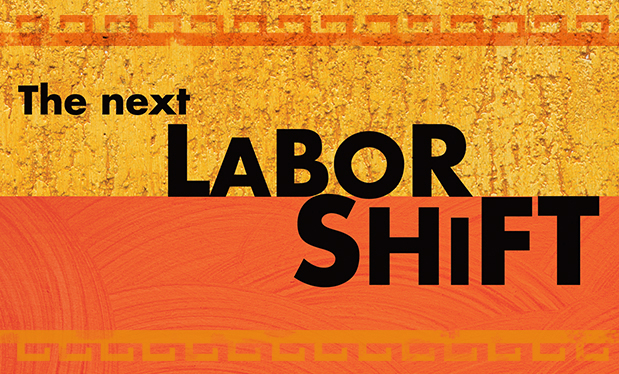Long known as a premium choice for roofing, metal has been making gains in the nonresidential market in recent years, and the trend looks favorable for the future. According to the "Consolidated Construction Study" published in 2015 by FMI Corp., Raleigh, N.C., and commissioned by the Metal Construction Association (MCA), since 2009, metal has achieved an annual growth rate in share percentage of about 4 percent.
MCA attributes this growth in metal roofing to several factors, such as energy efficiency, longevity and design flexibility.
Energy efficiency
According to Scott Kriner, MCA technical director, when repurposing a building, retrofit metal roof systems can be made more energy-efficient than most other types of roof systems because the cavity that is created between the original roof and the new metal retrofit roof provides opportunities to install energy-saving technologies. Using this concept, a team of leading metal construction companies and MCA were awarded a $1 million Environmental Security Technologies Certification Program grant from the Department of Defense (DOD) to develop a retrofit metal roof system with integrated renewable energy technologies.
The project involved an 11,900-square-foot retrofit metal roof system on a 10,000-square-foot security forces building at Goodfellow Air Force Base (AFB) in San Angelo, Texas. The project is unique because it integrates numerous energy-efficient technologies, including the following:
- Above-sheathing ventilation that uses the gap between the roof surface and sheathing to allow passive airflow to exit at the ridge of the roof combined with a "cool" reflective metal roof surface coating to reduce heat gain through the roof assembly up to 45 percent compared with a traditional dark roof surface
- Solar-thermal water-heating technology integrated into the roof cavity to capture solar energy for domestic hot water and space heating
- A rainwater capture system installed using an above-ground cistern with a 10,000-gallon capacity, expected to provide up to 131,000 gallons of water annually
- Roof panels laminated with a thin-film photovoltaic (PV) system to generate electricity
The project's main achievement was the demonstration of integrating roof system components into one retrofit system that has the potential to maximize electricity generation and minimize the building's cooling load. The solar-thermal technology integrated into the retrofit cavity will optimize the energy generated for domestic hot water and space heating. This solar-thermal technology is expected to yield more than 7.5 million BTUs of energy per year. With local utility costs taken into account, Goodfellow AFB is projecting a savings in energy costs of $11,750 per year.
The project's team is confident the integrated retrofit roof system will perform as predicted and allow for the technology to be transferred throughout DOD to other federal agencies and into the commercial building sector.
Advancements in roof coatings technology during recent years also have improved metal roof systems' energy efficiencies. Specially formulated cool roof coatings can allow metal roof systems in a variety of colors to achieve solar reflectance values of more than 70 percent, contributing to reduced heating and cooling costs.
The increased use of insulated metal panels also adds to a metal roof system's energy efficiency. Insulated metal panels consist of a monolithic foam core sandwiched between two metal sheets. These impermeable panels offer thermal values ranging from R-14 to R-44. In addition to offering superior energy efficiency, insulated metal panels are easy to install and come in a wide variety of colors, textures and finishes.
Longevity
Metal roof systems have long been the preferred choice for institutional and government building projects because of their long life expectancies.
In fact, according to FMI's 2015 report, when looking specifically at the institutional market, metal roofing has gained a 7.7 percent market share since 2009. Although metal may be more expensive initially compared with other materials, building owners can decrease the life cycle costs of their roof systems because metal does not need to be replaced as frequently as other roof systems.
In 2013, MCA conducted a Service Life Study of unpainted 55 percent aluminum-zinc standing-seam low-slope roof systems in the U.S. The study found the service lives of these types of metal roof systems were at least 60 years in certain regions and longer in other areas. The study concluded unpainted Galvalume® standing-seam low-slope roof systems in a wide range of environments experienced corrosion rates that conservatively project service lives that can exceed the service lives of most buildings, eliminating the need for costly reroofing projects.
Design flexibility
Architects frequently choose metal roof systems not only for their energy efficiency and durability but also because manufacturers offer a full spectrum of custom coatings, profiles and aesthetic appeals that enable designers to achieve just about any look they desire. Aesthetics are important for any project, and metal roof systems can be as visually appealing as they are long-lasting and energy-efficient.
"Vertical standing-seam roofs remain a popular choice and are gaining acceptance in the U.S.," says Jim Bush, vice president of sales for ATAS International Inc., Allentown, Pa. "But we see facsimile metal products that are made to look like other kinds of roofing materials also are gaining in popularity."
Metal roof systems can be made to look like slate, wood shake, clay tile or asphalt shingles. This allows a building owner or designer to achieve any look he or she desires while still taking advantage of the performance characteristics inherent in metal.
Ideal platform for solar
The longevity and durability of metal roof systems make them an ideal platform for solar technologies. PV systems are gaining popularity, and building owners who make the investment often choose a metal roof system because it matches or exceeds the life cycles of the PV systems. This means there is no costly reinstallation of the PV system because metal roof systems typically outlive PV systems. PV systems also can be attached to a standing-seam metal roof system with no penetration through the roof, eliminating the risk of leaks.
Retrofit projects
When building owners are looking for a new roof system for their existing buildings, retrofitting with metal is a popular choice because a complete, fully engineered metal roof system can be installed over existing low- or steep-slope roofs and can be applied over problematic roofs.
"The economy is still challenging, and many roofing contractors are finding metal for roof system retrofits to be an appealing option to expand their businesses," says Mark James, president at RetroSpec LLC, Dallas. "Metal over metal retrofits can be a win-win for the contractor and the building owner."
Contractors who have an established metal roofing business may have a list of aging roofs at their fingertips. With metal roof systems, they already have the necessary tools and equipment to complete the work.
Despite the many advantages of metal roofing, metal roof systems have their limitations. The use of metal roofing in highly corrosive environments, such as coastal regions or highly industrial areas, can be problematic. In such areas, corrosion rates may be excessive and can reduce the longevity of a metal roof system and affect its aesthetics. For roofing applications requiring the installation of excessive amounts of rooftop equipment, the use of metal roofing may be hindered by the amount of penetrations, curbing, flashing, support equipment and runoff from condensers.
Building on growth
As the construction industry continues to rebound, metal roof systems are well-positioned to continue their growth and expansion into other markets. FMI's Consolidated Construction Study forecasts metal roofing will gain market share through 2018 in the agricultural, commercial, industrial and institutional markets.
According to the study: "The metals industry has done a tremendous job of promoting metal usage as a premium product during a time when owners and specifiers are especially cost conscious."
Designers and building owners are recognizing the value inherent in metal despite its initial higher cost. They are seeking a solution that offers energy efficiency, longevity and diverse design, and metal roofing is the option that offers the best in all these characteristics.
Karl Hielscher is chair of the Metal Construction Association.



